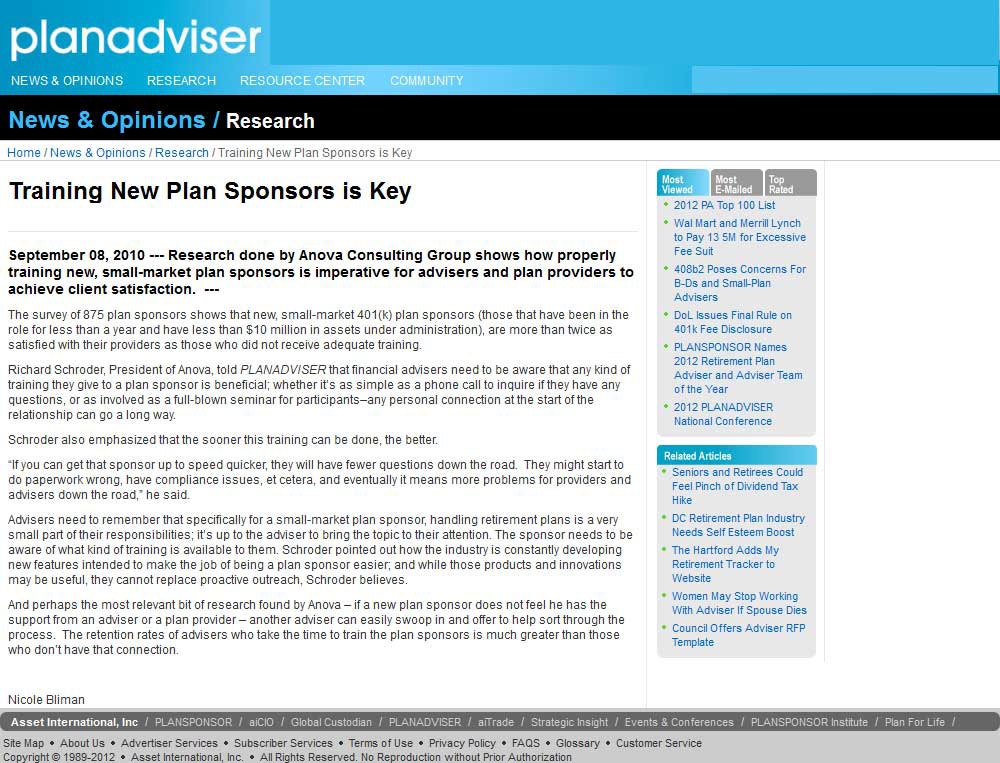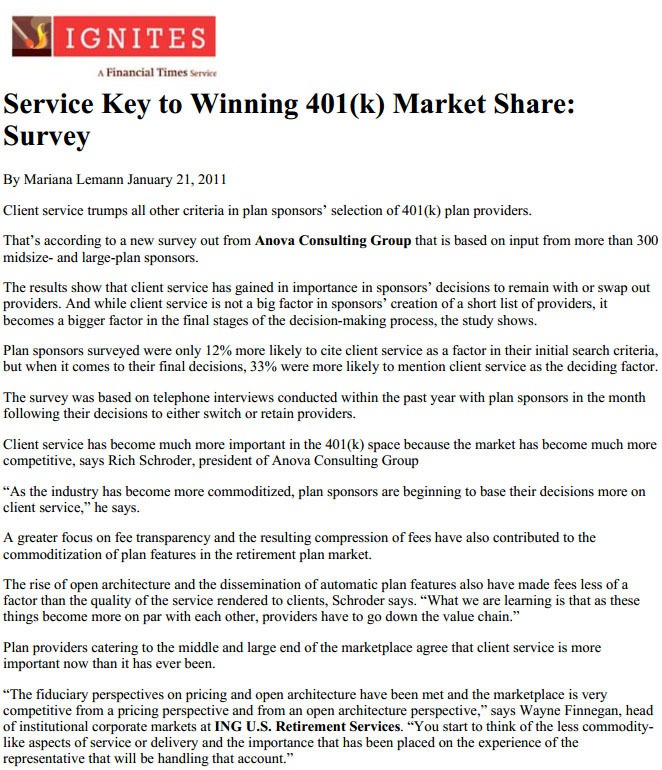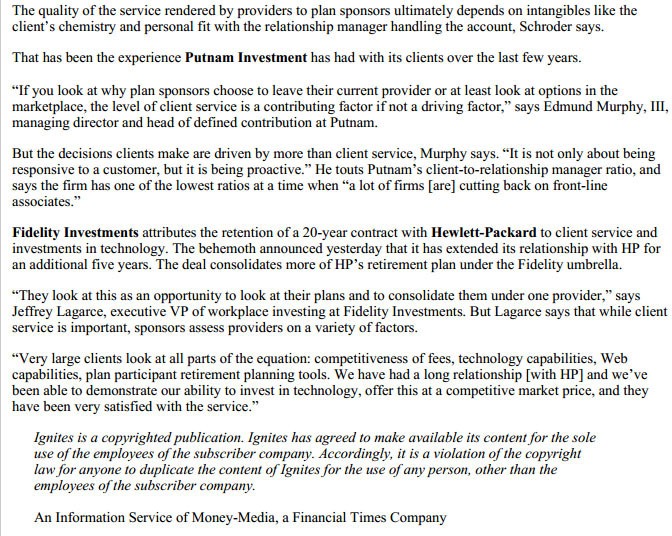

 There are many different methods to go about analyzing and understanding the overall satisfaction of your client base. But beyond this overall score, which is rating a vast number of your clients, are the sentiments of individual customers.
There are many different methods to go about analyzing and understanding the overall satisfaction of your client base. But beyond this overall score, which is rating a vast number of your clients, are the sentiments of individual customers.
Would you want to know exactly which of these clients are the unhappiest and why?
Most likely, your answer to the question above is affirmative. After all, these are the clients that are most at risk for leaving you, and as Bill Gates said, “Your most unhappy customers are your greatest source of learning.”
But how do you find out which clients fall into the At Risk category and what specifically is behind their dissatisfaction? The answer is right inside your client satisfaction program approach. By taking your client satisfaction study one step further, you can identify who these clients are and respond with personalized service that can save that potential ambulatory revenue from walking out on you.
Consider, perhaps, a couple new techniques. One technique is to ask a series of questions gaging your clients’ satisfaction with different attributes regarding the relationship. For example, you can ask them to rate how they feel about the value of your products and services relative to the fees paid, how they are treated as an important client, and their willingness to recommend your organization to someone else.
By uncovering and seeing your clients’ sentiments regarding these attributes, you will be able to determine who is not feeling satisfied with pivotal aspects of the relationship and who would consider leaving for someone else. The responses to these questions can also dig deeper into areas that the client may not have considered when rating their overall satisfaction.
Another technique is to openly ask your clients to rank their likeliness to continue the relationship with your company on a sliding scale. While slightly more brazen, it will be easy to decipher these more direct answers and understand which clients are At Risk.
As noted, after identifying these At Risk customers, it is important to follow-up with a personalized discussion. Look at the ratings for all the other attributes in your survey to identify which are the lowest, and (most likely) driving their dissatisfaction, and speak to how you plan on improving their experience regarding their pain points. Having the personalized discussion will show you care, have paid attention to their dissatisfaction, and are committed to improving the relationship.
Engaging a third-party to gather feedback from clients can be an invaluable strategy to obtain honest and unbiased insights. Having an external, investigating party provides a level of objectivity that clients may feel is lacking in internal surveys, making them more comfortable sharing their genuine thoughts and concerns. Third-party feedback is also often seen as credible and impartial, which can encourage clients to be more open in their responses. You can ensure that your survey is being conducted by people who are skilled at analyzing the data and transforming it into actionable recommendations. This invaluable insight enables your business to take swift and effective action to address client needs, enhancing overall satisfaction and client retention. The objective perspective and expertise of a third-party service can be a game-changer in creating a more client-centric approach to your business.
 Note: This is the third perspective piece on the different ways to analyze client satisfaction data. Previous posts focused on Overall Satisfaction Ratings and At Risk Accounts.
Note: This is the third perspective piece on the different ways to analyze client satisfaction data. Previous posts focused on Overall Satisfaction Ratings and At Risk Accounts.
One of the biggest drivers of satisfaction is the experience clients have with the personnel they interact with. Think about it: aggravations with products or qualms over pricing can be remedied by having someone you feel good about interacting with, someone who listens to your problems and tries to solve them. Organizations devote extensive resources to making sure the personnel that interact with their clients are professional, knowledgeable, and likeable. As such, gathering scores rating service team members is an important part of client satisfaction research.
Asking open-ended questions about the personnel can be very useful. It is important to give your clients the platform to openly share their opinions of what their service team is doing well or could improve on. It is also important to gather quantitative ratings on relevant attributes of the service personnel. When analyzed, scores for areas such as responsiveness, consultative approach, and quality of interactions can identify areas your team could improve their skillset.
After gathering a myriad of ratings for an individual team member, calculate the average for each attribute and see which areas someone may need additional training. A Relationship Manager may have high ratings for problem resolution skills and responsiveness, but lower scores for proactive approach. Consider ways to help that individual find their voice and reach out to clients without prompting (this can range from a simple “checking in to see how things are going” email to providing value-add content such as an invite to a relevant webinar).
In Year 1 of gathering ratings, make it clear that these initial results are a baseline, and track how service team members’ scores trend over time. When scores are improving, praise the personnel for realizing their weak points and improving them. If scores are trending downward, be sure to provide training and resources to your employee on how they can reverse that trend.
The baseline is not just relevant for day-to-day contacts but also management. For example, a new executive such as a Head of Service or COO should note the satisfaction scores in the first year of her new role, and track how the overall rating trends over the course of her tenure. Super users of client satisfaction research also tie in performance reviews and compensation to the year-over-year results of their study.
Scores should not be used as part of a witch hunt or to single out employees, but rather to identify areas where additional training can be provided to your employees. In the best situations, Anova’s clients are eager to receive their ratings each year, particularly looking to see if the areas they have been focused on with their customers are translating to improved scores. If the ratings are incorporated in a positive manner into your company’s culture, they can be used as a springboard for positive improvement and development.
 You’ve spoken to your clients. You’ve collected hundreds or even thousands of individual data points rating the relationship between your organization and your customers. And now you are looking at a spreadsheet filled with open-ended commentary and quantitative scores rating service team members, detailing pain points, and reflecting on the overall relationship between your two organizations.
You’ve spoken to your clients. You’ve collected hundreds or even thousands of individual data points rating the relationship between your organization and your customers. And now you are looking at a spreadsheet filled with open-ended commentary and quantitative scores rating service team members, detailing pain points, and reflecting on the overall relationship between your two organizations.
The most logical question is: What’s next?
Finding the answer to this question may seem overwhelming and you could be scratching your head wondering where to even start. It may help to begin by looking at the most fundamental questions that a client satisfaction study sets out to discover:
Discovering Who’s Happy (and Who’s Not)
While open-ended feedback is a critical component of a successful customer study, most executives still want to know the answer to the most essential reason for conducting client sat: What percentage of the client base is happy with the products and services they are receiving?
Whether you ask for a yes or no response or categorizing values on a numeric scale, a question in your survey should be designed to answer this very question. However, getting the percentage of satisfied clients isn’t necessarily the hard part; it’s understanding that number that can be more challenging.
Say 72% of your client base is satisfied. Is that good? Bad? How does it compare to your competitors? Is satisfaction increasing or decreasing compared to last year?
If you are using a third party to help conduct the study, they should be able to provide some benchmarking information for organizations like yours. However, in the absence of industry benchmarking data, tracking satisfaction over time may be the most useful way to apply context to your satisfaction score. Year-over-year trends can really help an organization understand how effective its service efforts and product enhancements are.
A negative score, one that is either lagging compared to the benchmark or trending downwards over time, is obviously cause for concern. The next step here should be to investigate further by looking at the scores and feedback for individual attributes to identify what aspect of your offering is troubling clients the most. It is also useful to look at these attributes even with a positive overall score, to fully get a sense of your clients’ feedback.
Diving deeper into the responses for individual questions is one way to get more granular with the data. Another is looking at each of your client’s individual responses. Doing this will allow you to understand which clients are satisfied, but more importantly, which are in danger of leaving. In our next blog post we will look at ways to analyze the data to discover which of your clients are “at risk”.

September 08, 2010 — Research done by Anova Consulting Group shows how properly training new, small-market plan sponsors is imperative for advisers and plan providers to achieve client satisfaction. —
The survey of 875 plan sponsors shows that new, small-market 401(k) plan sponsors (those that have been in the role for less than a year and have less than $10 million in assets under administration), are more than twice as satisfied with their providers as those who did not receive adequate training.
Richard Schroder, President of Anova, told PLANADVISER that financial advisers need to be aware that any kind of training they give to a plan sponsor is beneficial; whether it’s as simple as a phone call to inquire if they have any questions, or as involved as a full-blown seminar for participants–any personal connection at the start of the relationship can go a long way.
Schroder also emphasized that the sooner this training can be done, the better.
“If you can get that sponsor up to speed quicker, they will have fewer questions down the road. They might start to do paperwork wrong, have compliance issues, et cetera, and eventually it means more problems for providers and advisers down the road,” he said.
Advisers need to remember that specifically for a small-market plan sponsor, handling retirement plans is a very small part of their responsibilities; it’s up to the adviser to bring the topic to their attention. The sponsor needs to be aware of what kind of training is available to them. Schroder pointed out how the industry is constantly developing new features intended to make the job of being a plan sponsor easier; and while those products and innovations may be useful, they cannot replace proactive outreach, Schroder believes.
And perhaps the most relevant bit of research found by Anova – if a new plan sponsor does not feel he has the support from an adviser or a plan provider – another adviser can easily swoop in and offer to help sort through the process. The retention rates of advisers who take the time to train the plan sponsors is much greater than those who don’t have that connection.
For Immediate Release
Contact: Andrew Cloutier
Anova Consulting Group, LLC
(617) 731-1045
andrew@anovaconsulting.com
BROOKLINE, MASS., September 7, 2011 – According to a new survey by Anova Consulting Group, LLC, a leading market research firm in the financial services and human capital management sectors, small- market 401(k) plan sponsors who have a clear understanding of the roles of their service team members are 31% more likely to be satisfied with their providers than those who do not understand the distinct responsibilities of each team member.
Of over 2,000 small market plan sponsor survey respondents (with less than $10 million in plan assets), a full 34% said that they did not clearly understand the roles of their service team members. Those who said they fully understand service team members‟ roles and responsibilities reported an 83% overall level of satisfaction, compared with 63% overall satisfaction level reported by sponsors who were confused by service team roles.
“Our survey shows that the most successful retirement plan providers are those who have clearly defined roles across service team members and proactively communicate these roles to plan sponsors,” said Richard Schroder, president of Anova Consulting Group. “Service team role clarity is especially important in the small-plan market, where sponsors tend to be business owners (or appointed personnel) for whom administering the 401(k) plan is only a small part of their job description. They need to know whom to call to get their issues resolved quickly, and they have little time or patience to be re-directed after an initial inquiry.”
Another way in which having well-defined roles and responsibilities helps sponsor satisfaction is by setting clear service level expectations. The two areas in the survey in which satisfaction ratings suffer most when sponsors don‟t understand service team roles are “treats me as an important client” and “employee education materials and meetings”. Sponsors who clearly understand service team roles are 57% more likely to feel like they are treated as an important client and 55% more likely to be satisfied with their provider‟s employee education offering. “In situations where sponsor expectations have not been managed by the plan provider, sponsors are more likely to feel that their provider is not being proactive or helping as much as they could.” said Schroder.
An additional challenge in the small market is the prevalence of unbundled plans, in which the presence of TPAs can further complicate the service picture. According to Schroder, “It is especially critical for plan providers to have clearly defined service roles in unbundled situations. “Finger-pointing‟ among TPAs, FAs, and plan providers is a sure recipe for sponsor dissatisfaction.” Survey results show that unbundled plan sponsors are 24% less likely to clearly understand service team roles than their bundled counterparts.
In summary, Schroder stated, “This is an important finding because it is relatively easy for 401(k) plan providers to address. This survey shows that establishing clear roles in the service organization and communicating them to plan sponsors can be a cost effective way to significantly improve client satisfaction and retention.”
Established in 2005, Anova Consulting Group is a leading market research and consulting firm focused on Win / Loss analysis and client satisfaction Analysis. By helping its clients understand why they win, lose and retain business, Anova provides strategic perspectives to its clients, driving better decision-making, product development, sales effectiveness, client service, and continuous improvement. Last year, Richard Schroder, president of Anova, released a book about Win Loss Analysis titled, From a Good Sales Call to a Great Sales Call (McGraw-Hill, 2011), which details how learning from post-sale Win / Loss debriefing helps close more sales.
September 7, 2011 (PLANSPONSOR.com) – According to a new survey by Anova Consulting Group, LLC small-market 401(k) plan sponsors who have a clear understanding of the roles of their service team members are 31% more likely to be satisfied with their providers than those who do not understand the distinct responsibilities of each team member.
Of over 2,000 small market plan sponsor survey respondents (with less than $10 million in plan assets), 34% said that they did not clearly understand the roles of their service team members. Those who said they fully understand service team members’ roles and responsibilities reported an 83% overall level of satisfaction, compared with 63% overall satisfaction level reported by sponsors who were confused by service team roles.
According to a press release, another way in which having well-defined roles and responsibilities helps sponsor satisfaction is by setting clear service level expectations. The two areas in the survey in which satisfaction ratings suffer most when sponsors don‟t understand service team roles are “treats me as an important client” and “employee education materials and meetings.” Sponsors who clearly understand service team roles are 57% more likely to feel like they are treated as an important client and 55% more likely to be satisfied with their provider’s employee education offering.
An additional challenge in the small market is the prevalence of unbundled plans, in which the presence of TPAs can further complicate the service picture. Survey results show that unbundled plan sponsors are 24% less likely to clearly understand service team roles than their bundled counterparts.
September 07, 2011 — Small-market 401(k) plan sponsors who have a clear understanding of the roles of their provider team members are more likely to be satisfied with their providers than those who do not understand the distinct responsibilities of each team member. —
The survey by Anova Consulting Group consisted of more than 2,000 small market plan sponsors; those with less than $10 million in plan assets. Thirty-four percent said that they did not clearly understand the roles of their service team members. Those who said they fully understand service team members’ roles and responsibilities reported an 83% overall level of satisfaction, compared with 63% overall satisfaction level reported by sponsors who were confused by service team roles.
Having well-defined roles and responsibilities also helps sponsor satisfaction levels by setting clear expectations. The two areas in the survey in which satisfaction ratings suffer most when sponsors don’t understand service team roles are “treats me as an important client” and “employee education materials and meetings.” Sponsors who clearly understand service team roles are 57% more likely to feel like they are treated as an important client and 55% more likely to be satisfied with their provider’s employee education offering.
An additional challenge in the small market is the prevalence of unbundled plans, in which the presence of TPAs can further complicate the service picture.


By Mariana Lemann January 21, 2011
Client service trumps all other criteria in plan sponsors’ selection of 401(k) plan providers.
That’s according to a new survey out from Anova Consulting Group that is based on input from more than 300 midsize- and large-plan sponsors.
The results show that client service has gained in importance in sponsors’ decisions to remain with or swap out providers. And while client service is not a big factor in sponsors’ creation of a short list of providers, it becomes a bigger factor in the final stages of the decision-making process, the study shows.
Plan sponsors surveyed were only 12% more likely to cite client service as a factor in their initial search criteria, but when it comes to their final decisions, 33% were more likely to mention client service as the deciding factor.
The survey was based on telephone interviews conducted within the past year with plan sponsors in the month following their decisions to either switch or retain providers.
Client service has become much more important in the 401(k) space because the market has become much more competitive, says Rich Schroder, president of Anova Consulting Group
“As the industry has become more commoditized, plan sponsors are beginning to base their decisions more on client service,” he says.
A greater focus on fee transparency and the resulting compression of fees have also contributed to the commoditization of plan features in the retirement plan market.
The rise of open architecture and the dissemination of automatic plan features also have made fees less of a factor than the quality of the service rendered to clients, Schroder says. “What we are learning is that as these things become more on par with each other, providers have to go down the value chain.”
Plan providers catering to the middle and large end of the marketplace agree that client service is more important now than it has ever been.
“The fiduciary perspectives on pricing and open architecture have been met and the marketplace is very competitive from a pricing perspective and from an open architecture perspective,” says Wayne Finnegan, head of institutional corporate markets at ING U.S. Retirement Services. “You start to think of the less commodity- like aspects of service or delivery and the importance that has been placed on the experience of the representative that will be handling that account.”
The quality of the service rendered by providers to plan sponsors ultimately depends on intangibles like the client’s chemistry and personal fit with the relationship manager handling the account, Schroder says.
That has been the experience Putnam Investment has had with its clients over the last few years.
“If you look at why plan sponsors choose to leave their current provider or at least look at options in the marketplace, the level of client service is a contributing factor if not a driving factor,” says Edmund Murphy, III, managing director and head of defined contribution at Putnam.
But the decisions clients make are driven by more than client service, Murphy says. “It is not only about being responsive to a customer, but it is being proactive.” He touts Putnam’s client-to-relationship manager ratio, and says the firm has one of the lowest ratios at a time when “a lot of firms [are] cutting back on front-line associates.”
Fidelity Investments attributes the retention of a 20-year contract with Hewlett-Packard to client service and investments in technology. The behemoth announced yesterday that it has extended its relationship with HP for an additional five years. The deal consolidates more of HP’s retirement plan under the Fidelity umbrella.
“They look at this as an opportunity to look at their plans and to consolidate them under one provider,” says Jeffrey Lagarce, executive VP of workplace investing at Fidelity Investments. But Lagarce says that while client service is important, sponsors assess providers on a variety of factors.
“Very large clients look at all parts of the equation: competitiveness of fees, technology capabilities, Web capabilities, plan participant retirement planning tools. We have had a long relationship [with HP] and we’ve been able to demonstrate our ability to invest in technology, offer this at a competitive market price, and they have been very satisfied with the service.”
WESTWOOD, Mass., Jan. 4, 2012 / PRNewswire / — New York Life Retirement Plan Services, a leading provider of retirement solutions to U.S. corporations and unions, is pleased to announce the availability of “Consensus,” a service powered by Anova Consulting Group LLC, a financial services market research and sales training firm, that will help top retirement plan advisors assess client satisfaction and measure themselves against peers.
This new service will allow top retirement plan advisors to evaluate current client satisfaction levels and generate quantitative and qualitative feedback on advisor service delivery. It also will provide segmentation analysis, benchmarking against retirement advisor peers, and identification of at-risk and satisfied clients. Advisors do not need to have retirement plans on New York Life’s platform in order to participate.
“At New York Life, we prioritize client service excellence and we know that for advisors in this marketplace, close client relationships are the lifeblood of their business,” said Patrick Murphy, managing director of sales at New York Life Retirement Plan Services. “We want to drive better outcomes for our advisors, sponsors and participants – and we see Consensus as a natural complement to our ongoing focus on client satisfaction.”
“Getting honest insight from your customer base is critical, but hard to do,” said Rich Schroder, president of Anova Consulting Group. “And that insight is so much more valuable with perspective. Consensus gives sponsors the opportunity to provide feedback in a confidential environment, allowing retirement plan advisors to evaluate their own practice and compare it to their peers and competitors.”